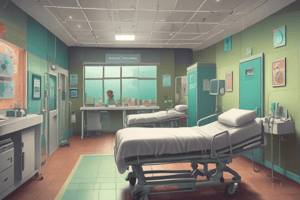Podcast
Questions and Answers
What are nosocomial infections commonly known as?
What are nosocomial infections commonly known as?
- Community-acquired infections
- Chronic infections
- Hospital-acquired infections (correct)
- Pathogen infections
Which type of nosocomial infection is most often associated with catheter use?
Which type of nosocomial infection is most often associated with catheter use?
- Surgical Site Infections
- Bloodstream Infections
- Urinary Tract Infections (correct)
- Ventilator-associated pneumonia
What is a common risk factor for nosocomial infections?
What is a common risk factor for nosocomial infections?
- Prolonged hospital stays (correct)
- Healthy diet
- Routine check-ups
- Regular exercise
Which of the following pathogens is a common cause of nosocomial infections?
Which of the following pathogens is a common cause of nosocomial infections?
What is an important strategy for preventing nosocomial infections?
What is an important strategy for preventing nosocomial infections?
Which of the following outcomes is associated with nosocomial infections?
Which of the following outcomes is associated with nosocomial infections?
What does antibiotic stewardship aim to achieve?
What does antibiotic stewardship aim to achieve?
In managing nosocomial infections, what is essential for resolution?
In managing nosocomial infections, what is essential for resolution?
Flashcards are hidden until you start studying
Study Notes
Definition
- Nosocomial infections, also known as hospital-acquired infections (HAIs), are infections acquired in a healthcare setting.
Common Types
- Urinary Tract Infections (UTIs)
- Often associated with catheter use.
- Surgical Site Infections (SSIs)
- Occur following surgery.
- Pneumonia
- Ventilator-associated pneumonia (VAP) is a common type.
- Bloodstream Infections (BSIs)
- Often related to central lines and IV catheters.
Risk Factors
- Prolonged hospital stays.
- Invasive procedures (e.g., surgeries, catheterization).
- Use of antibiotics (which can disrupt normal flora).
- Immunocompromised patients (e.g., chemotherapy, diabetes).
Common Pathogens
- Bacteria
- Staphylococcus aureus (including MRSA).
- Escherichia coli.
- Klebsiella pneumoniae.
- Clostridium difficile.
- Viruses
- Influenza.
- Norovirus.
- Fungi
- Candida species.
Prevention Strategies
- Hand Hygiene
- Regular hand washing and use of alcohol-based hand sanitizers.
- Sterile Techniques
- Use of sterile instruments and maintaining a sterile environment.
- Antibiotic Stewardship
- Appropriate use of antibiotics to minimize resistance.
- Surveillance
- Monitoring infection rates and implementing control measures.
Impact
- Increased morbidity and mortality rates.
- Extended hospital stays and increased healthcare costs.
- Potential for disability in severe cases.
Management
- Identification of the causative organism.
- Appropriate antimicrobial therapy.
- Infection control measures to prevent spread.
- Monitoring and follow-up to ensure resolution.
Definition
- Nosocomial infections, or hospital-acquired infections (HAIs), are infections obtained within healthcare environments.
Common Types
- Urinary Tract Infections (UTIs) are frequently linked to catheter usage.
- Surgical Site Infections (SSIs) arise post-surgery, affecting recovery.
- Ventilator-associated pneumonia (VAP) is a major form of pneumonia acquired in hospitals.
- Bloodstream Infections (BSIs) are often due to central lines and IV catheters.
Risk Factors
- Prolonged hospital admissions increase susceptibility to infections.
- Invasive procedures, such as surgeries and catheter placements, heighten risks.
- Use of antibiotics may disrupt normal bacterial flora, leading to infections.
- Immunocompromised individuals, including those undergoing chemotherapy or with diabetes, are at greater risk.
Common Pathogens
- Bacteria include:
- Staphylococcus aureus (notably MRSA)
- Escherichia coli
- Klebsiella pneumoniae
- Clostridium difficile
- Viruses include:
- Influenza virus
- Norovirus
- Fungi primarily include:
- Various species of Candida
Prevention Strategies
- Hand hygiene through regular washing and alcohol-based sanitizers is crucial.
- Sterile techniques are vital for using instruments and maintaining cleanliness.
- Antibiotic stewardship emphasizes correct antibiotic usage to avoid resistance.
- Surveillance involves tracking infection rates to enforce control measures effectively.
Impact
- Nosocomial infections lead to higher morbidity and mortality rates.
- They result in longer hospital stays and escalate healthcare expenditures.
- Severe cases can cause lasting disabilities.
Management
- Management starts with identifying the specific causative organism.
- Effective antimicrobial therapy is essential for treatment.
- Infection control measures are required to prevent transmission.
- Continuous monitoring and follow-up are necessary to ensure resolution of infections.
Studying That Suits You
Use AI to generate personalized quizzes and flashcards to suit your learning preferences.




